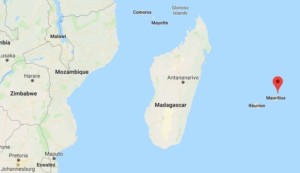The first BOU John & Pat Warham Studentship
I am incredibly proud to introduce myself as the first of the BOU’s John and Pat Warham-funded PhD students. My PhD is focusing on a unique population of Pterodroma petrels breeding on Round Island, in the Western Indian Ocean. I am working with Professor Jenny Gill and Dr Simon Butler at the University of East Anglia, in conjunction with Dr Malcolm Nicoll and Professor Ken Norris of the Zoological Society of London (ZSL), and Dr Norman Ratcliffe of the British Antarctic Survey. Somehow, I am already eight months into my PhD, and the BOU have given me this opportunity to tell you about the project and what I’ve been up to in that time.
World-renowned for his wildlife photography and avian ecology, John Warham (1919-2010) was one of the pioneers of seabird field research. Often accompanied by his wife Pat, John visited numerous sub-Antarctic islands in the southwest Pacific. His research focused mainly on the Procellariiforms and penguins of New Zealand, publishing a very important two-volume monograph on the petrels that is indispensable to any marine ornithologist. To support further research of Sphenisciform and Procellariiform seabirds, John and Pat very generously left a legacy to the BOU for postgraduate research.
Round Island petrels
Round Island petrels are medium-sized, surface-nesting gadfly petrels. They have a range of different colour morphs and, whilst originally identified as Trindade Petrels (Pterodroma arminjoniana), it has relatively recently been revealed that this population is in fact a mixed, hybridizing population with at least two additional species – Kermadec (P. neglecta) and Herald petrels (P. heraldica).

Figure 1. Round Island lies immediately to the north of Mauritius in the Indian Ocean.
Since 1993, this population of petrels has been the focus of a detailed nest monitoring and ringing programme, resulting in one of the most comprehensive data sets relating to the ecology of a tropical seabird in the world. A 10-year collaborative (ZSL, Mauritian Wildlife Foundation, and National Parks and Conservation Services) tracking programme has shown that these petrels undertake non-breeding migrations (typically of six months) to different areas across much of the tropical Indian Ocean, with 1% of successfully tracked birds also visiting the Pacific and Atlantic Oceans. This, together with the fact that birds can be found breeding on Round Island all year round, means that individuals are potentially exposed to a very wide range of environmental conditions and human-associated impacts. It is unclear how this variability might impact on petrel breeding success, survival, and ultimately the petrel population. This is where I come in!
First year study
For the first step of my PhD, I am interested in the likely rates and directions of avian responses to environmental change during migration. Can individuals respond flexibly to the environmental conditions that they experience? Recently, studies have begun to address this question by contrasting the amount of variation within individual migrations with the variation between individuals, using repeatability analysis. This individual-based approach has been made possible by recent advances in remote-tracking technology (primarily satellite telemetry, and more recently through light-level geolocators), across a wide range of taxa (seabirds, landbirds and waterbirds). I became interested in how repeatability estimates might vary using different technologies, as well as across the annual cycle, and with study design (sample size, duration of study etc.). For example, if individuals are tracked with satellite or GPS, which provide more precise data than possible from geolocators or colour-ring observations, are repeatability values likely to be higher? Are pre-breeding stages (e.g. arrival at breeding grounds) going to be more consistent and time-sensitive than post-breeding stages? If individuals are tracked for a longer period of time, are repeatability values likely to be lower?
I have identified 43 studies that estimate repeatability of avian migratory timings, which include 151 repeatability estimates covering arrival and departure dates from the breeding and non-breeding grounds. I am now in the process of combining and analysing these data to check for any systematic biases that may occur and I am working on a manuscript for publication.
Next steps
In the second stage of my PhD, I shall be using a 10-year tracking dataset of the Round Island petrel to assess repeatability of migration for this species. I am fortunate to have data for over 70 individual petrels that have been tracked with geolocators for two or more multiple migrations. I therefore wanted to take this opportunity to thank the many people involved in collecting this data – my supervisors Malcolm Nicoll and Ken Norris at ZSL, Norman Ratcliffe at BAS, Mauritian Wildlife Foundation and National Parks and Conservation Services, as well as the many Round Island wardens, staff and volunteers who have deployed and recovered geolocators over the past 10 years.
I am still in the early stages of analysis but preliminary work shows Round Island petrels to be pretty consistent! (Fig. 2) What I find interesting is, if this population of petrels can be found breeding on Round Island all year round, then what might be constraining them to be so individually consistent?

Figure 2. Two examples of adult Round Island petrels showing consistent individual differences in their migratory routes and timings. Each point represents a location at solar midday and solar midnight for every day tracked, and each colour represents a month. The yellow triangle represents the tagging location on Round Island, Mauritius.
Using genetic and environmental data, I also plan to explore the associations between individual genotype (which describes individual origin), the environmental conditions experienced, and the migratory routes and timings that are undertaken, to investigate the potential consequences at the individual and population levels.
This article is based on this poster presentation for #BOU2019 and this Twitter presentation for the 5th World Seabird Twitter Conference #WSTC5.
Image credits
Featured image: Round Island petrel Pterodroma sp © Malcolm Nicoll




